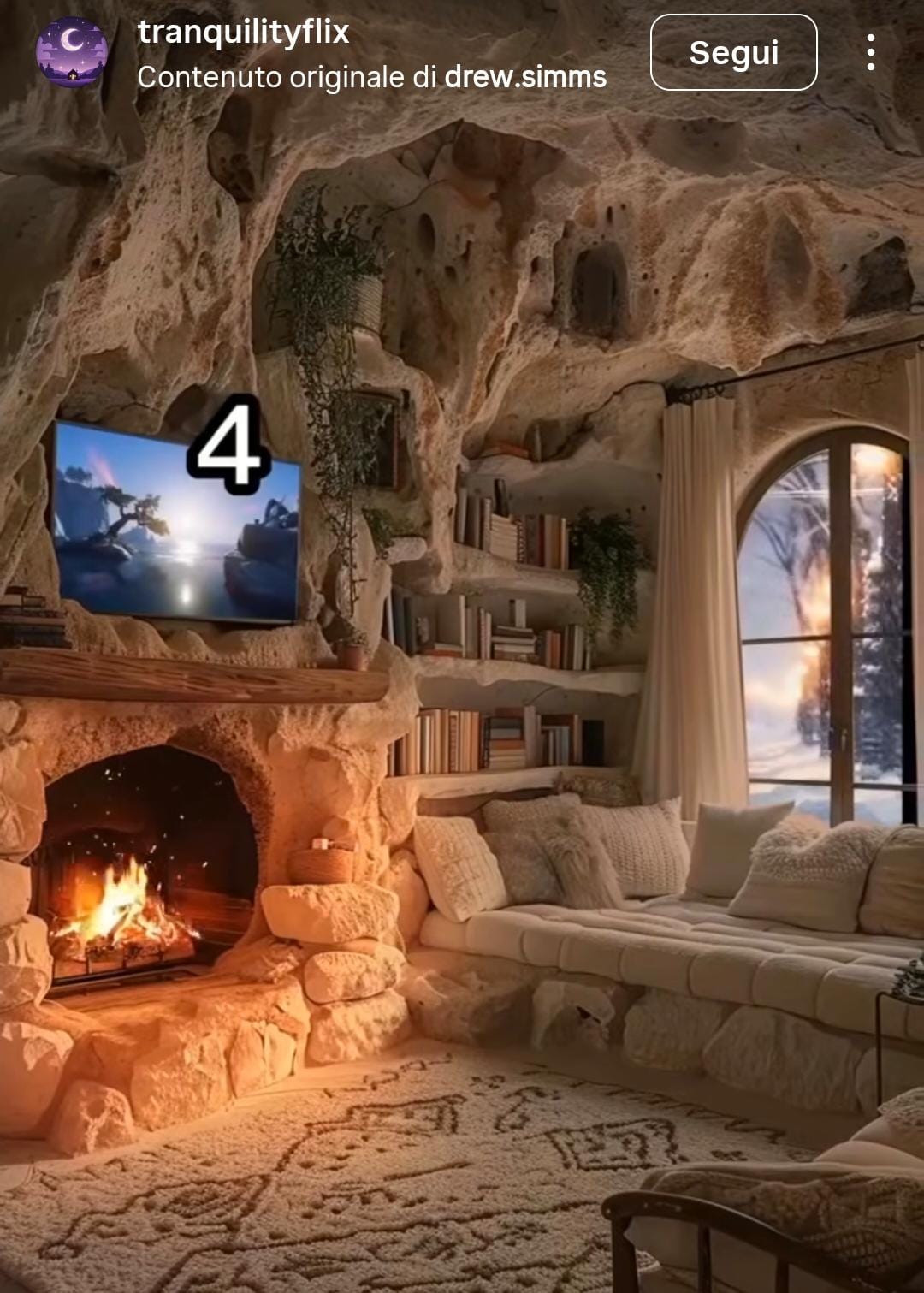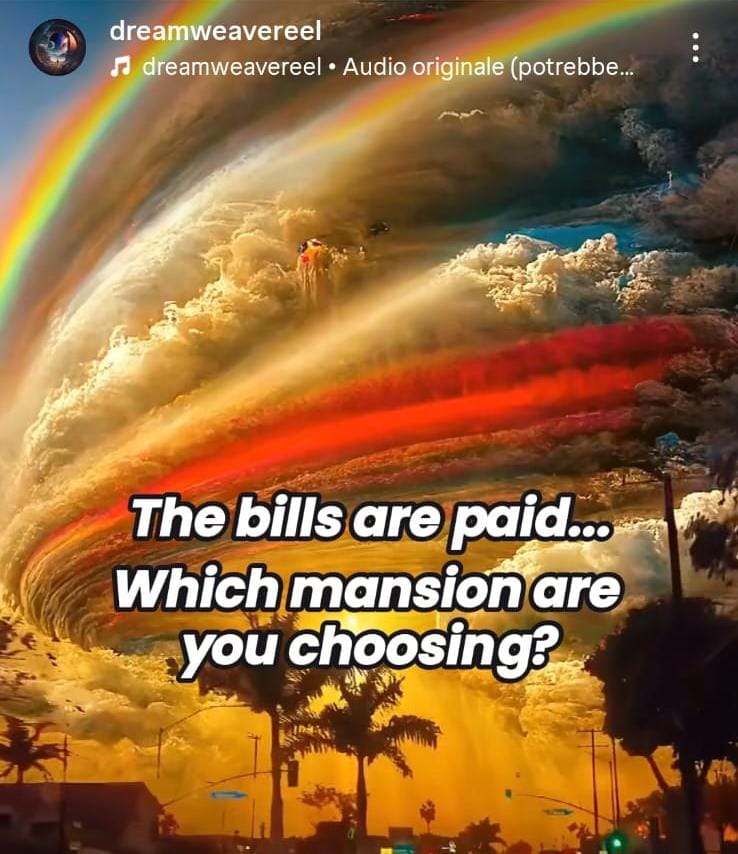Due to a fractured ankle, I’m now experiencing an extended stay at home for the first time since 2020. I had fantasized about this moment for a long time, because I belong to that group of people who – whether for better or worse – were happy during lockdown. It’s a feeling that’s been dubbed “quarantine nostalgia”: a form of idealization that emerged over time, which online, especially on TikTok, translated into a wave of commemorative content recalling that strange period.
When I can’t sleep – against every doctor’s recommendation – I find myself endlessly scrolling, looking for relaxing content. That’s how I ended up in a curious spiral of reels: a niche among thousands of pages showcasing artistic AI-generated images and landscapes, which I discovered are deeply rooted in the romanticization of lockdown.
The videos I’m referring to are a sort of simplified personality test, where you’re simply asked to choose something, with no outcome or explanation: “If you know your boyfriend well, which of these houses would he choose?”, “You have to isolate for a year, which house do you pick?”, or “You haven’t slept in two days – which of these beds would you rest in?” The images that follow are AI-generated and numbered so viewers can choose. They depict homes set in different landscapes that match specific clich – s: desert, jungle, snowy mountain, forest, or big city. The interiors follow suit, idealizing absolute comfort with piles of cushions, giant screens, fireplaces lit while a storm rages outside. I’d call them visual ASMR – pages from a furniture catalog of another dimension.
The pages themselves feel like liminal spaces: they have similar, impersonal names – relaxvibes, dreamland, tranquilityflix. User comments are short, almost ritualistic: “house 2 and 6,” “4 looks cozy.” The links in their bios lead to image packs, fake giveaways promising trips to imaginary places, or Etsy pages selling puzzles and posters of the visuals used in the videos. I wondered who was behind these pages and out of curiosity, I messaged one. The admin replied, identifying as human, but confirmed my suspicion that many of these accounts are bot-run, reposting videos stolen from other pages.

What intrigued me most was that nearly all these posts featured the hashtag #nostalgia, often followed by #vibes or #relax. While this combination is common across various corners of the internet – where nostalgia for the past is often linked to peace and comfort, and to images of liminal, empty spaces (think Vaporwave or Dreamcore) – I couldn’t immediately understand how it applied here. Then I came across these same videos introduced with prompts like, “There’s a new pandemic, which house do you spend quarantine in?” or “It’s 2020 again, where are you staying?” – and I began to follow that trail. On TikTok, the birthplace of nearly every trend that hits Instagram months later, I searched for the song used in most of these videos – Let Go by Ark Patrol – and traced the trend’s origin.
The trend is closely tied to this song: originally released in 2015, it went viral in the spring of 2020, seemingly capturing the melancholic tone of the early pandemic months. In Ark Patrol’s track, Veronika Redd’s airy vocals emerge like an echo from a distant room, the music builds a liquid landscape of reverb and suspended beats, where time feels like it melts. “This song makes me feel like: people I never met, a world I was never in, a feeling I had never experienced before, and memories I never had,” reads one of the most liked comments under the YouTube video. Shortly thereafter, the track was revived as a nostalgic anthem of the lockdown on TikTok and became the soundtrack to the type of videos I’m describing.
This is a textbook example of “nowstalgia”, a portmanteau of now and nostalgia, referring to the phenomenon of feeling nostalgic for very recent events or trends. This accelerated form of nostalgia is particularly prevalent among Gen Z, and is tied to the rapid rise and fall of online trends. The COVID-19 pandemic amplified this effect: lockdown and social distancing distorted our perception of time and experience, creating the sense that even recent moments already belonged to the past.
In April 2020, as reported by the internet culture archive Know Your Meme, a game went viral in which people had to choose which celebrity-inhabited house they’d spend quarantine in. But even before that, in March, articles and threads were already circulating, prompting people to pick their ideal lockdown home – if only they had known what was coming. Many later regretted not moving elsewhere when they had the chance. Those articles mainly featured celebrity mansions, but also fictional homes from movie sets or digitally created ones – likely the origin of the visuals in these videos.

Many of the houses featured in these reels are luxurious villas with vast spaces, gardens, and breathtaking views. Often, the prompt is explicitly tied to wealth: “You can have a house for free – which do you choose?” or “You won the lottery – pick your house.” This brings us back to one of the harsh truths of the pandemic: housing inequality. Restrictions were much harder on those living in small, airless spaces without balconies or light. Those days made us long for places that – even today, in digital form – we continue to seek.
But there’s another component: the dreamlike one. These videos often begin with surreal, slow-motion scenes – like a lucid dream. They’re hypnotic: a hand trailing through water, a jump through the clouds, a canoe floating on a lake. The frequent presence of water visually links these reels to the concept of dream immersion, further emphasized by the song’s echoes. These POVs also resemble first-person video games. In fact, some game developers have used the trend to promote new titles. But here, the game consists only of choosing a setting; after the intro, there’s nothing but scenic contemplation. The admin I spoke to said: “The opening clips are mainly meant to grab attention – they’re relaxing, eye-catching, not really meaningful, just aesthetically pleasing.”
It’s almost amusing how much care goes into crafting a dreamy frame just to present something as basic as a bedroom. But maybe that’s the point: the simplicity of desire. Space, quiet, rest – a game for its own sake. Naturally, the trend has evolved into stranger and more absurd versions. The questions have become increasingly specific and ironic: from “Which house would you live in?” to “Which alien bar would you get blackout drunk in with your friends?”, or “Which fantasy world would you set off for an adventure in?” There are also many medieval-themed pages now – a popular aesthetic at the moment.
The explosion of this content reflects a shift in the digital ecosystem: a rise in purely visual environments, where images are not just content, but language, identity, atmosphere. They don’t try to sell us anything or teach us anything. The admins don’t speak. Trying to understand what motivates someone to run such an account, I asked directly. The answer was simple: “I just enjoy making videos and entertaining people.”
In an era where social media is saturated with personal narratives, strong opinions, and hyper-curated lives, there’s a growing need for digital spaces that offer visual silence and emotional comfort. Personal content – even when authentic – often triggers social comparison, anxiety, and inadequacy. In 2019, theorist McKenzie Wark wrote that “social media are no longer just spaces of opinion, but visual archives of the soul” (Capital Is Dead) – a sentiment that feels increasingly true. Online identity is now built less through words and more through colors, textures, moods – in short, vibes.
We’re witnessing a return to what’s now called slow content, and the rise of immersive digital environments. A May 2025 article in The Times reports that Gen Z is gradually leaving platforms like Meta, opting instead for spaces perceived as more authentic and less commercialized – like Tumblr or Pinterest. And when we think back to “quarantine nostalgia,” the link becomes clear: what we missed most from that time was exactly the slowness, the silence, the empty streets, the long days filled with small, simple things.
As author Legacy Russell writes, “In digital aesthetics we’re not seeking affirmation, but resonance: we want to feel reflected, not watched” (Glitch Feminism, 2020). In this context, platforms like Pinterest and these silent Instagram archives become spaces where self-construction happens through what we save and collect – or through choosing the imaginary house we wish we could live in.
Viola Giacalone, or Viola Val – ry, born in Florence in 1996, is a Florentine journalist, writer and memer. She graduated in comparative literature at the Sorbonne Nouvelle in Paris, with a master’s thesis on new creative writing on the web. She continued her studies in cultural journalism at the City College of New York and at the Accademia Treccani in Rome. She currently collaborates with various publishing, cultural and radio organisations (Controradio Florence, RadioRaheem Milan).